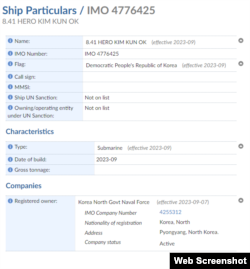In an unexplained and puzzling move, North Korea this week placed 13 of its several dozen known submarines on a public list maintained by an international maritime agency, only to have them removed a day later.
North Korea on Tuesday registered 11 Sang-O II-class submarines, as well as two more sophisticated vessels, with the International Maritime Organization's (IMO) Global Integrated Shipping Information System (GISIS), even though military craft are not normally listed on the registry.
By Wednesday, all 13 submarines had been removed from the list.
When asked about the removal, a spokesperson for the IMO told VOA Korean on Thursday that "member states may request to have their own data updated."
"GISIS is an online hub for the sharing of shipping-related data, based on information provided by member states," the spokesperson added.
Rare move
It is unclear what motivated Pyongyang's initial registration of the submarines, which was first reported Tuesday by VOA Korean.
Besides the 11 Sang-O II-class submarines, Pyongynang registered the Yongung, which is capable of launching ballistic missiles, and the Hero Kim Kun Ok, which is believed to have the capability to carry nuclear-armed ballistic missiles.
The Hero Kim Kun Ok was described by North Korea as its first operational "tactical nuclear attack submarine" at a launch ceremony in September 2023, just days before North Korean leader Kim Jong Un traveled to Russia.
A South Korean Foreign Ministry spokesperson told VOA Korean on Thursday that "the government is monitoring closely the situation related to North Korea's acquisition of IMO vessel identification numbers" after the registration was reported.
A unique seven-digit identification number is assigned to a ship that registers with the IMO.
The same day the submarines were taken off the list, North Korea boasted that its naval forces "have developed into elite matchless ones" and referred to August 28 as "the Day of the Navy of the Korean People's Army," according to the country's state-run media KCNA.
Choi Won Il, the retired captain of South Korea's sunken naval ship Cheonan, told VOA Korean on Wednesday he found it "unusual" that North Korea had listed its submarines on a public registry, "because submarines are designed to be stealthy warships." South Korea accused the North of sinking the Cheonan in 2010.
The IMO is a U.N. agency responsible for regulating maritime traffic, but warships are not required to be placed on its registry. The 13 submarines were registered as nonmerchant vessels operated by the Korean People's Army Naval Force.
'Unlawful' weapons
A spokesperson for the State Department told VOA Korean on Wednesday that the U.S. was "aware of reports that the DPRK registered 13 military submarines" with the IMO and was "consulting closely" with South Korea, Japan and other allies and partners.
DPRK stands for the Democratic People's Republic of Korea, North Korea's official name.
The spokesperson continued, "We condemn the DPRK's continued efforts to advance its unlawful WMD [weapons of mass destruction] and ballistic missile programs" and "call on the DPRK to refrain from its further destabilizing actions and return to dialogue."
North Korea test-fired a 240 mm multiple rocket launcher with a new guidance system under the supervision of Kim, KCNA said Wednesday.
In addition to its ground capabilities, North Korea in recent years has emphasized boosting its underwater capabilities.
In January, North Korea said it test-fired the Pulhwasal-3-31, a newly developed submarine-launched strategic cruise missile, and the Haeil-5-23, an underwater nuclear launchable drone.
In April, construction of a new submarine similar to the Hero Kim Kun Ok at North Korea's Sinpho South Shipyard was detected on commercial satellite imagery examined by 38 North, a program of the Stimson Center devoted to analyzing North Korea.
Growing threat
North Korea has one of the world's largest submarine fleets, with an estimated 64 to 85 vessels, according to the Nuclear Threat Initiative, a nonpartisan global security organization.
"Submarines are viewed as an asymmetric capability whose stealth allows them to be a dangerous security threat," said Terence Roehrig, a professor of national security and a Korea expert at the U.S. Naval War College.
"Though North Korean submarines are noisy" and "limited in how far they can operate from coastal waters," the nation has "one of the largest submarine forces in the world and remains a serious maritime concern," he said.
North Korea first acquired Soviet-era Romeo-class submarines from China in the 1970s, according to the Nuclear Threat Initiative.
All submarines that were previously registered with IMO are considered diesel-powered submarines.
The Yongung is a Gorae-class, also known as the Sinpo-class submarine, which was launched in 2014 and has limited capability to stay underwater for more than a few days without surfacing, according to NTI.







